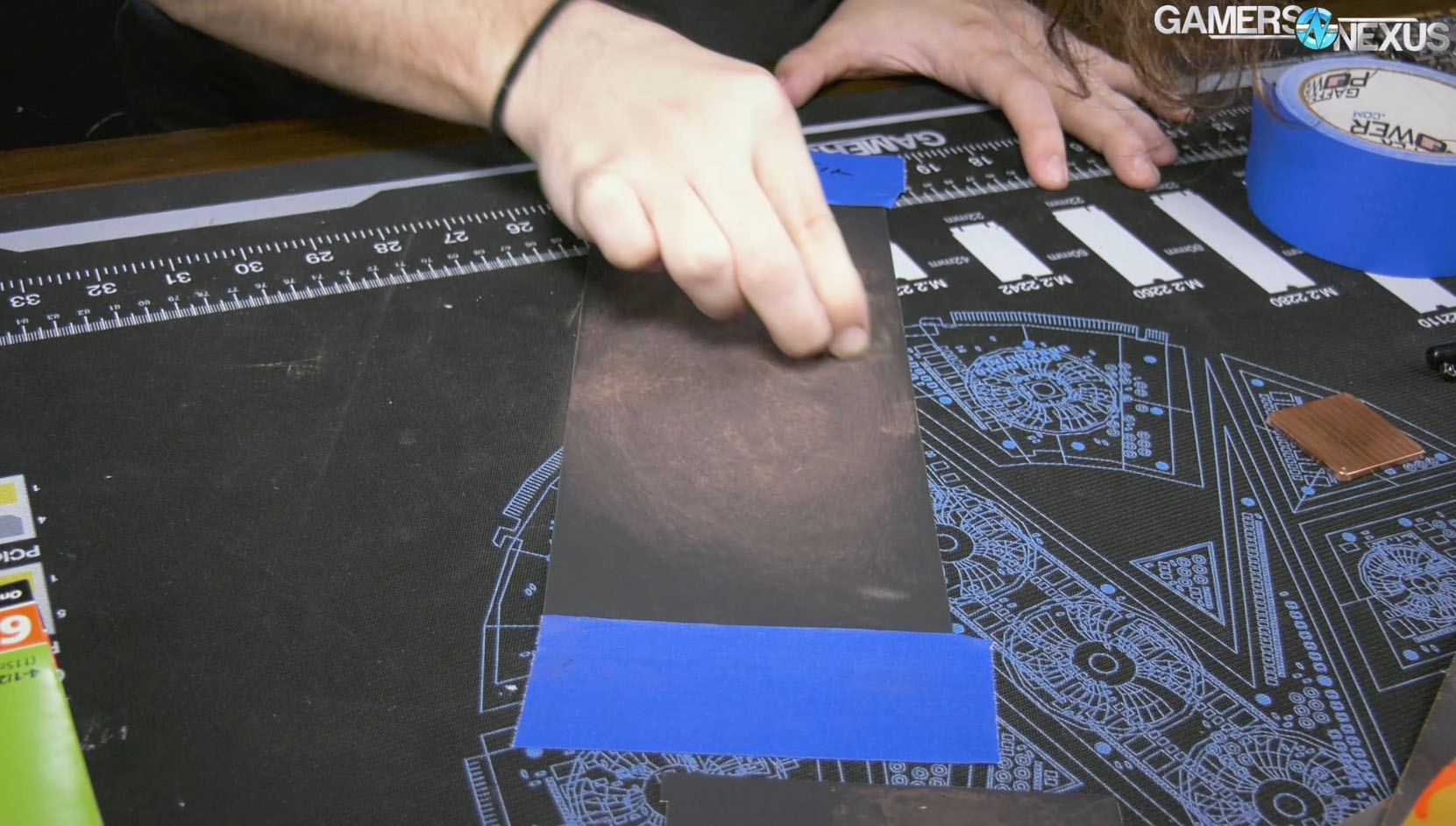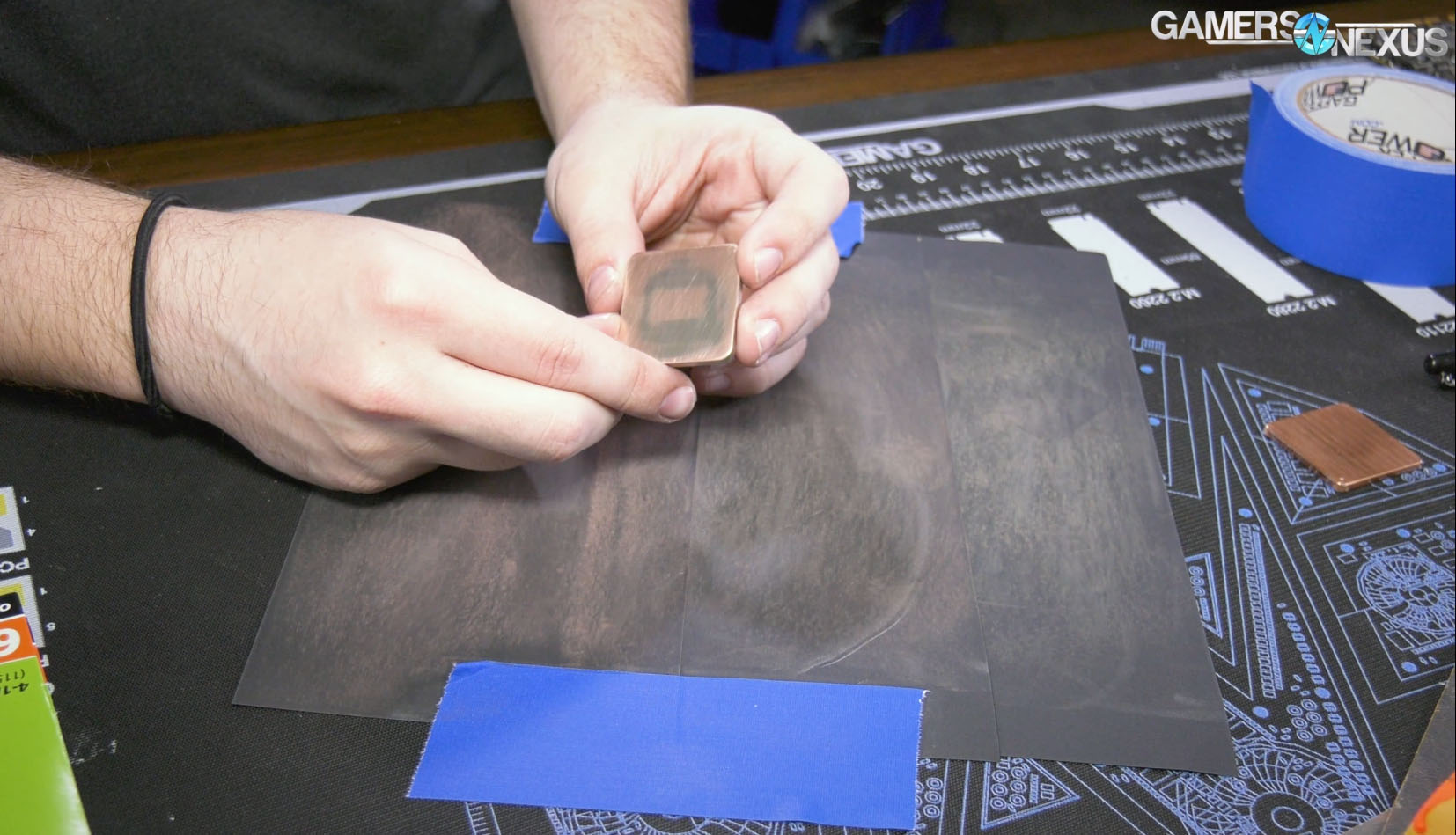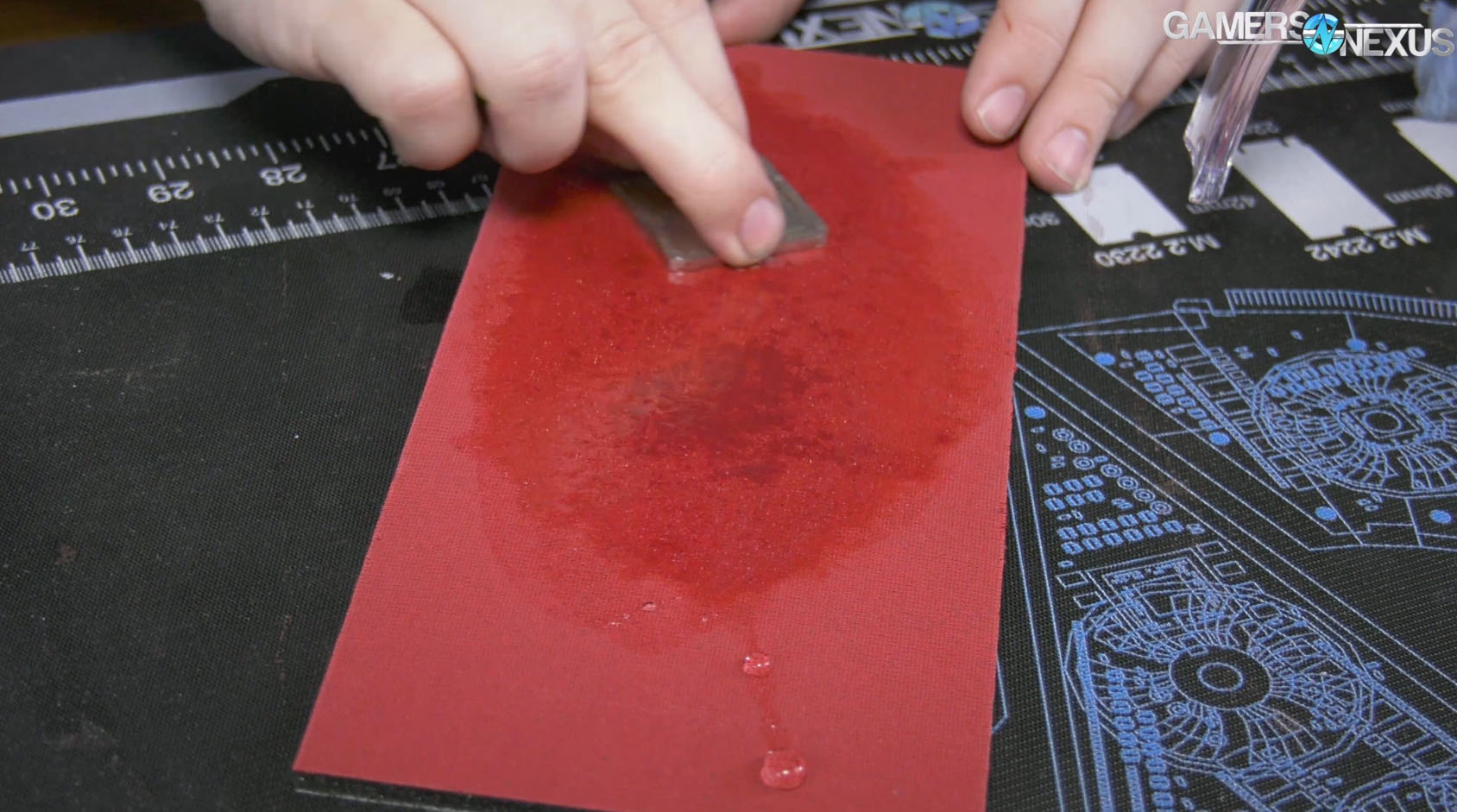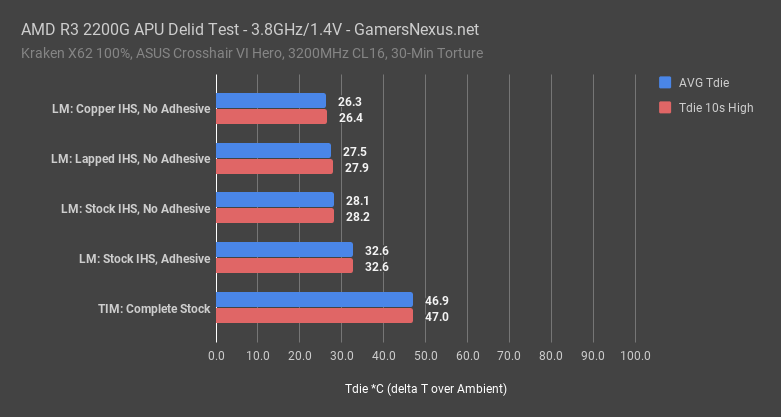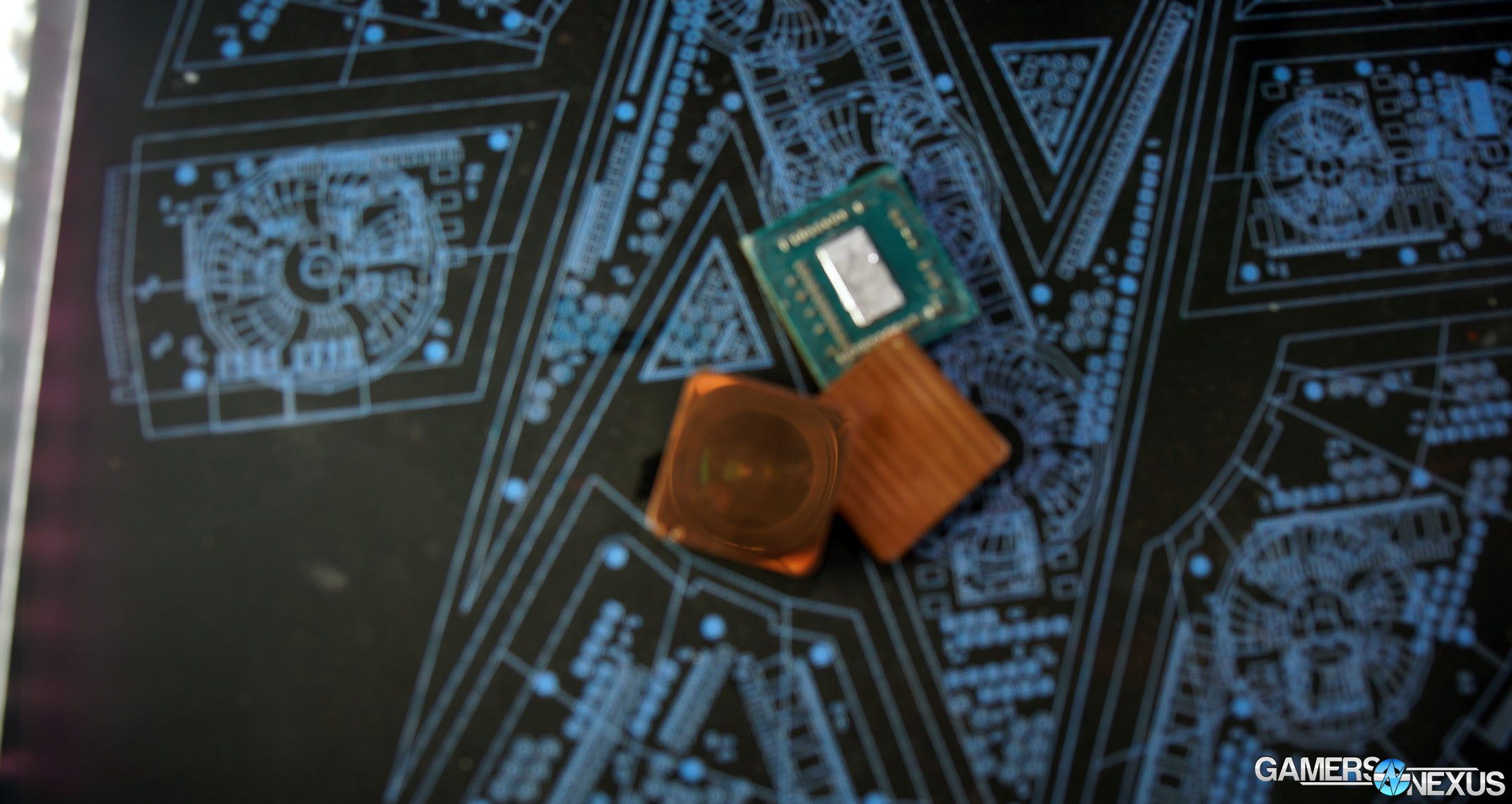In case you find it boring to watch an IHS get sanded for ten minutes, we’ve written-up this recap of our newest video. The content features a lapped AMD Ryzen APU IHS for the R3 2200G, which we previously delidded and later topped with a custom copper Rockit Cool IHS. For this next thermal benchmark, we sanded down the AMD Ryzen APU IHS with 600 grit, 1200 grit, 1500 grit, 2000 grit, and then 3000 grit (wet) to smooth-out the IHS surface. After this, we used a polishing rag and compound to further buff the IHS (not shown in the video, because it is exceptionally boring to watch), then we cleaned it and ran the new heatspreader through our standardized thermal benchmark.
Lapping the IHS
Short of using a power sander, which we avoided as we wanted manual control over the process, we found it worked best to tape the sandpaper to the surface (atop a GamersNexus Anti-Static Modmat), then move the decoupled IHS over surface. We ran three sanding passes for each grit, finishing with wet sands for each. After the third and final (wet) sand at 600 grit, we moved to 1200 grit.
And repeat: Another three sanding passes of this, eventually removing the entirety of the nickel plating on the IHS surface. We finished with a wet sand again, then moved to 1500 grit, 2000, and 3000. The 3000 grit sand was also done wet, and smoothed out the surface.
We finally polished and buffed the IHS, then ran it through our testing.
Test Methodology
First a note: We’re jamming 1.4V into the APU at just 3.8GHz for the CPU clock speed. The GPU component is not put under load during this test, as we’re focusing on generating significant heat from power virus workloads that leverage AVX instructions exclusively. We also were not concerned about a maximum OC on the frequency, just with generating a lot of heat. The 1.4V does that. LLC 8 is used on the C6H.
This testing is run with an ASUS Crosshair VI Hero motherboard, which means we’re only torturing the CPU for thermals. CPU+GPU load simultaneously would generate more load (with the GPU component generating upwards of 35W of heat pre-overclock), but we just need to establish a baseline for performance today. We are testing an R3 2200G. Memory is a kit of Geil EVO X 3200MHz CL16 DRAM, accompanied by a Kraken X62 CLC (stock fans, max fan and pump speed). Some tests were conducted with the stock air cooler (max fan speed). Although not a serious attempt at an overclock, we generated additional heat by configuring a fixed 3.8GHz and 1.4V for the APU, which was primarily used to demonstrate higher vs. lower power load performance (thermally).
An NZXT Hale90 V2 PSU is used for the power supply, on which we’ve clamped the EPS12V cables for accurate CPU power measurements. This is as opposed to wall measurements, which are inaccurate and should not be used for CPU power metrics at this level.
A fully automated thermal benchmark is used for the test. We’re burning with Prime95 28.5, which pulls ~5.6A to ~6.5A, depending on APU and clocks/volts. We’ve found this to be similar to Blender AVX workloads, in some instances. The burn is allowed to run for 30 minutes. We collect a 10-second high for the peak number, and an average high (at steady state) for the AVG CPU core temperature. Liquid temperature is also logged, where relevant, as is current and power.
Thermal compound is used on top of the IHS. We are using a graduated syringe to ensure the same amount of compound run-to-run, then manually spreading it over the surface.
Results: AMD Ryzen CPU Lapping vs. Stock IHS
Previously, we were hitting 26.3 degrees Celsius over ambient for the Rockit Cool IHS without any silicone adhesive, our best thermal result. The stock Ryzen IHS without adhesive and without lapping held a 28-degree result, which is just barely outside of our error margins for this testing. Functionally, they are the same result, though measurably different. The stock IHS with silicone adhesive, which creates a bit of a z-height gap that needs to be filled with more TIM under the IHS, measured at 32.6 degrees over ambient. Complete stock was 47 degrees.
For our new test with the lapped IHS, we ran three test passes with newly applied Conductonaut liquid metal for each pass, found here, and averaged at about 27.5 degrees. We're within error margins for either flanking result, and so can say we've lost measurement resolution as to the differences. It looks like, logically, the results indicate we can get toward the Rockit Cool IHS thermally with lapping. It took more than $20 of sandpaper to get there, and so exceeded the cost of Rockit Cool's IHS, and also took an hour of time, but you can certainly push closer to its performance. Perhaps with even more polish, we'd be at equivalence. For now, the differences are outside of our measurement resolution.
Conclusion
It’s not particularly exciting. You’d get far more gains just from a delid, liquid metal, and careful removal of all the silicone adhesive. It’s a fun project and we are outside of measurement resolution for differences between the custom copper Rockit Cool IHS and the standard IHS, and we think you could likely achieve equivalence with even more polish and sanding. That said, if you’re buying sand paper for this task, you’re already at price equilibrium with the Rockit Cool IHS (assuming they sell it again). Ultimately, none of this is necessary. The APUs run cool enough to not need it. Delidding is helpful and would allow you to run quieter fan RPMs, but beyond a delid, little can be gained from IHS modifications.
It’s still a fun project in that it makes the CPU more unique, though, and that’s part of the enthusiast spirit.
Editorial, Testing: Steve Burke
Video: Andrew Coleman
